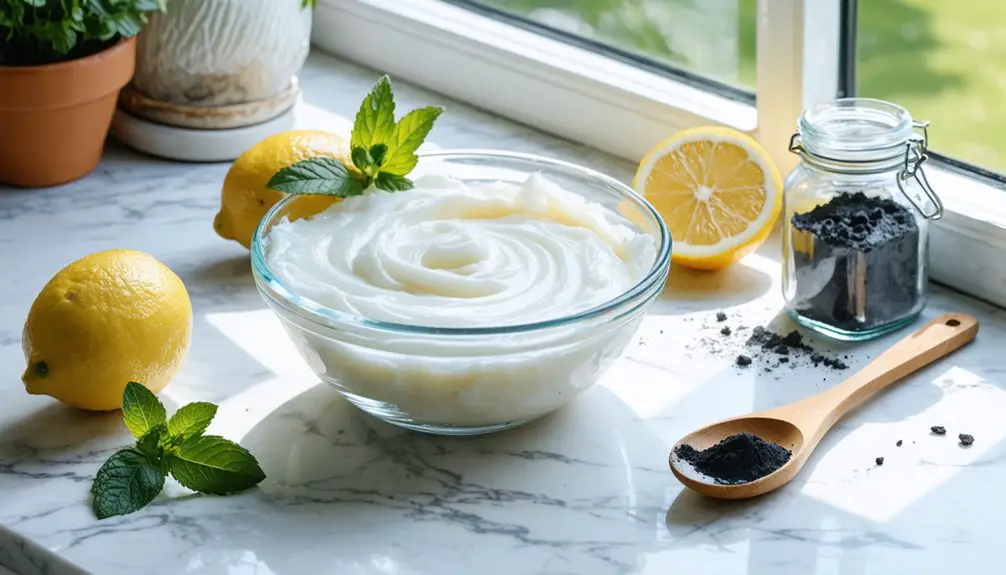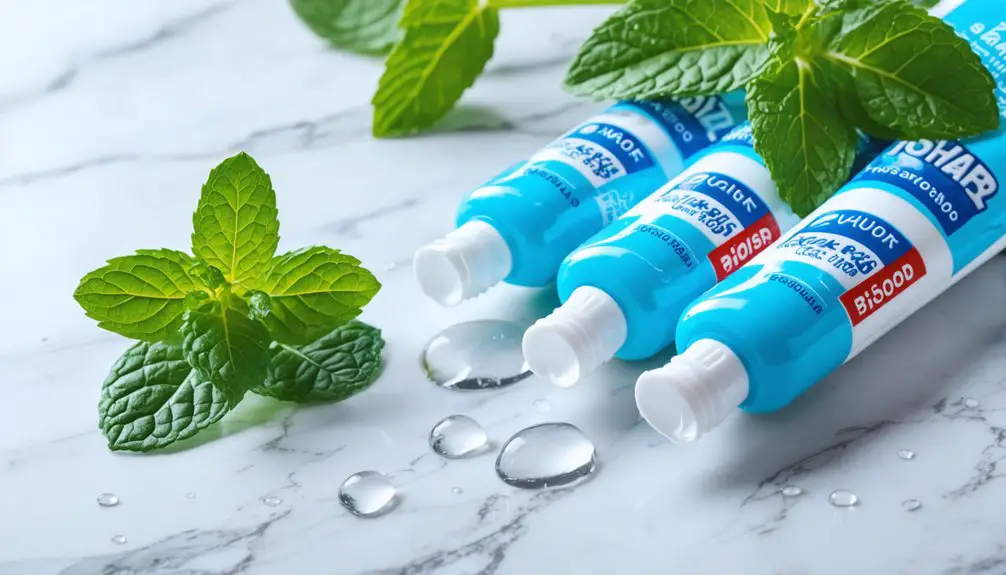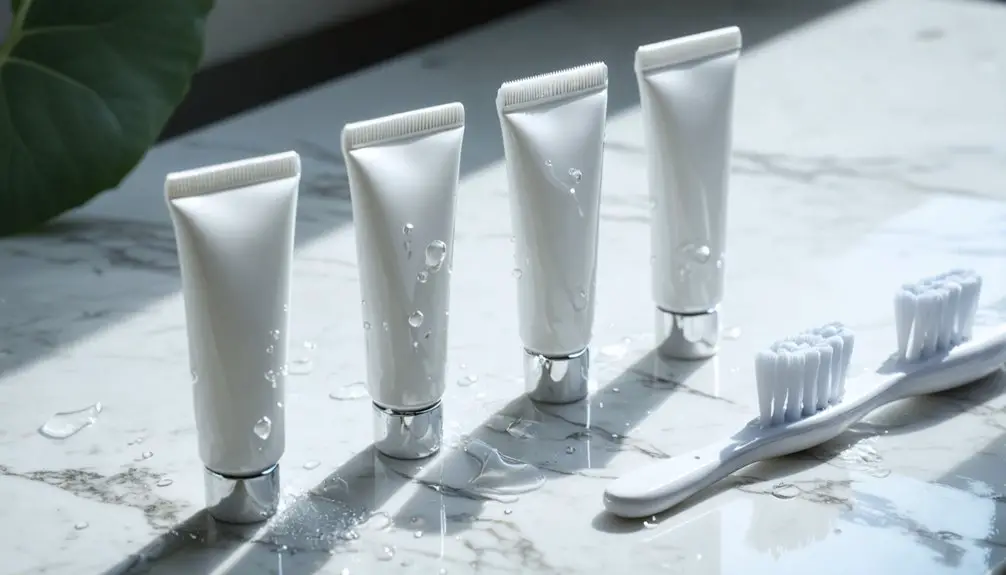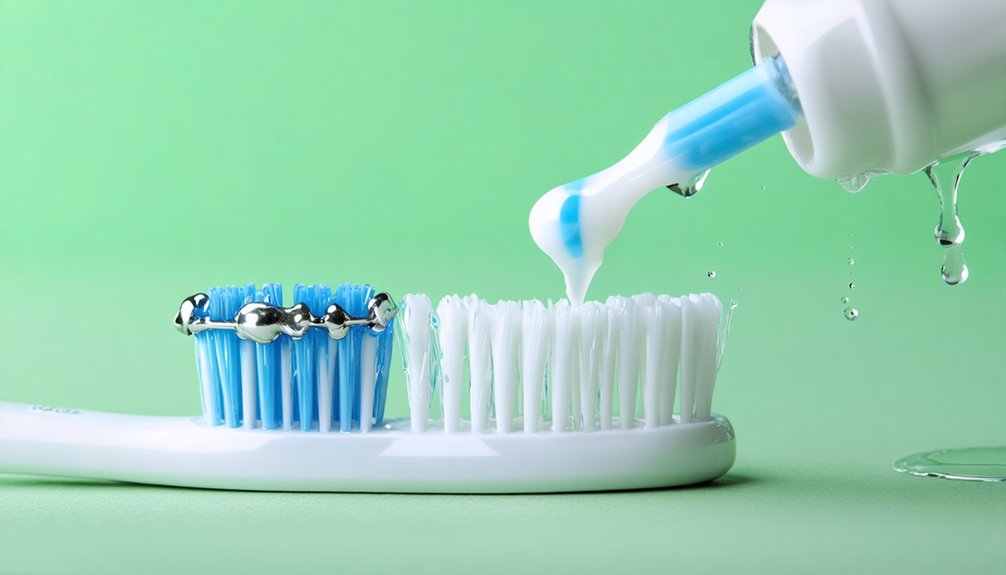You can create an effective whitening toothpaste by mixing baking soda with coconut oil in a 1:1 ratio, adding a pinch of sea salt and 2-3 drops of peppermint essential oil. Apply this mixture gently with a soft-bristled brush 2-3 times weekly for ideal results, following up with regular fluoride toothpaste. The mild abrasive action and pH-neutralizing properties will help remove surface stains and fight plaque buildup. Learn precise measurements and advanced techniques to maximize your natural whitening results.
Key Takeaways
- Mix 1 part baking soda with 1 part water to create a basic whitening toothpaste, using twice weekly for safe enamel protection.
- Combine baking soda with coconut oil, sea salt, and peppermint essential oil for an effective antibacterial whitening paste.
- Brush gently in circular motions for two minutes using a soft-bristled toothbrush to protect enamel while whitening.
- Expect initial whitening results within 2-3 weeks of regular use, with deeper stains requiring 6-12 weeks of treatment.
- Add xylitol powder for sweetness and cavity protection, storing the mixture in a sealed glass container away from light.
Understanding Baking Soda’s Whitening Power
While many people turn to expensive whitening treatments, baking soda offers a scientifically-proven method for removing surface stains from teeth through its dual mechanism of mild abrasive action and pH neutralization.
You’ll find that baking soda benefits include gentle polishing of extrinsic stains from substances like coffee, tea, and wine without harsh chemicals that could damage your enamel health. Studies have shown that ARM & HAMMER™ products consistently deliver effective whitening results.
Its natural alkalinity creates an environment that’s less hospitable to plaque-causing bacteria, helping prevent future stain formation. The mild abrasiveness of baking soda makes it safer than many commercial whitening agents, even at higher concentrations.
When you brush with baking soda consistently, you’re not only removing surface discoloration but also neutralizing harmful acids that can weaken and discolor tooth enamel over time. For optimal results, experts recommend gentle circular motions while brushing to effectively lift stains without damaging enamel.
The Science Behind Sodium Bicarbonate in Oral Care
To understand sodium bicarbonate’s role in oral care, you’ll need to examine its core chemical behavior. When dissolved in water, sodium bicarbonate separates into sodium and bicarbonate ions, creating an alkaline environment that directly impacts your oral microbiome.
This chemical process disrupts plaque formation by breaking bonds within the biofilm matrix. The bicarbonate ions neutralize harmful acids, converting them into water and carbon dioxide that you’ll naturally expel through breathing. pH buffering agents like sodium bicarbonate help maintain optimal acid-base balance in the mouth.
The bicarbonate ion’s chemical action weakens plaque structures while neutralizing acids, transforming them into harmless water and carbon dioxide byproducts.
This pH-raising action discourages acidophilic bacteria while supporting your mouth’s natural remineralization processes. As the alkaline environment penetrates plaque, it weakens its structure, making it easier for you to remove during brushing. Using a toothpaste with 67% sodium bicarbonate concentration provides optimal plaque-fighting benefits.
Clinical studies show that sodium bicarbonate toothpastes can reduce plaque buildup up to four times more effectively than non-bicarbonate alternatives.
Essential Ingredients for Your Homemade Toothpaste
Building an effective homemade toothpaste starts with selecting the right combination of scientifically-supported ingredients.
You’ll need to combine abrasive agents, moisturizing bases, natural sweeteners, and binding elements to create a balanced formula that’s both effective and pleasant to use.
- Start with baking soda as your primary abrasive, adding sea salt for enhanced antibacterial properties.
- Choose coconut oil as your base ingredient, benefiting from its natural antimicrobial properties and smooth texture.
- Incorporate peppermint essential oil for freshness, while xylitol offers essential ingredient benefits as both a natural sweetener alternative and cavity fighter.
- Adjust consistency with warm coconut oil or distilled water until you achieve a spreadable paste that won’t separate during storage.
The mechanical action of brushing is most important, as proper technique matters more than the toothpaste ingredients alone.
For optimal storage and longevity, keep your homemade toothpaste in a cool, dark spot to maintain its quality and prevent ingredient degradation.
Step-by-Step Mixing Instructions
Creating an effective homemade toothpaste requires a methodical mixing process to achieve the right texture and consistency.
Begin by combining baking soda with a small amount of toothpaste in a clean mixing bowl. Gradually incorporate coconut oil and sea salt, stirring thoroughly until well-blended. You’ll need to adjust the proportions based on your climate, using more baking soda in warm weather and less in cooler conditions. The cleaning power of this mixture is similar to what makes it work on limescale when used for sink cleaning. The gentle abrasive nature of baking soda helps remove surface stains effectively.
For customizable flavors, add xylitol powder to mask the salty taste while maintaining dental benefits. If the mixture’s too thick, incorporate small amounts of dish soap until you reach your desired consistency.
Consider ingredient substitutions based on your preferences, but maintain the core ratio of baking soda to liquids. Store your finished product in a sealed glass container for ideal freshness.
Safe Usage Guidelines and Best Practices
When mixing your DIY baking soda toothpaste, use a 1:1 ratio of baking soda to water to create a paste-like consistency that won’t be overly abrasive. This natural mixture provides antibacterial properties that help fight tooth decay.
You’ll want to limit usage to 2-3 times per week to protect your enamel, always following up with regular fluoride toothpaste. This extra step is crucial since baking soda lacks essential fluoride for proper tooth remineralization.
While brushing with your baking soda mixture, use gentle circular motions with a soft-bristled toothbrush and rinse thoroughly afterward to remove any gritty residue.
Mixing Ratios and Frequency
Making safe and effective DIY baking soda toothpaste requires precise mixing ratios and careful attention to usage frequency.
For maximum enamel safety and whitening effectiveness, you’ll need to balance the concentration of ingredients while monitoring your brushing routine. The standard water ratio is one part baking soda to two parts water, creating a paste that’s gentle enough for oral hygiene while still being effective.
- Mix 1 teaspoon of baking soda with just enough water to form a spreadable paste.
- Limit baking soda toothpaste alternatives to 1-2 times weekly to protect enamel.
- Prepare fresh mixture before each use rather than storing to maintain effectiveness.
- Consider adding a small amount of fluoride toothpaste to guarantee cavity protection while whitening.
Precautions While Brushing
To protect your dental health while using baking soda toothpaste, you’ll need to follow specific safety protocols that minimize potential risks to enamel and soft tissue.
Always moisten your toothbrush before applying a pea-sized amount of baking soda. Use gentle, circular motions with a soft-bristled brush to prevent gum irritation and enamel wear. Limit brushing sessions to two minutes or less, and don’t brush more than a few times per week.
After use, rinse thoroughly to remove all residual particles. Since baking soda lacks fluoride, supplement your routine with regular fluoride toothpaste on alternate days. Monitor for any signs of sensitivity or gum irritation, and discontinue use if problems develop.
Schedule regular dental check-ups to guarantee your enamel remains healthy with ongoing use.
Maximizing Results With Proper Application
You’ll achieve ideal whitening results by maintaining gentle, consistent pressure during each brushing session to avoid damaging your enamel.
Time your whitening sessions for at least two minutes, ensuring you cover all tooth surfaces with circular motions of your baking soda paste mixture.
Track your brushing duration with a timer or electric toothbrush to establish proper habits that maximize stain removal while protecting your oral health.
Brush With Gentle Pressure
Proper brushing technique stands as the cornerstone of safe and effective baking soda tooth cleaning. When applying your DIY baking soda toothpaste, you’ll need to master the gentle technique to protect your teeth’s enamel.
Using a soft-bristled toothbrush, apply minimal pressure while making small, circular motions to distribute the paste evenly.
- Think of the pressure application as a massage rather than a scrub – your bristles should barely bend.
- Maintain consistent, light pressure throughout your one-minute brushing session.
- Use circular motions to protect your gums while effectively removing surface stains.
- Stop immediately if you experience any discomfort or sensitivity.
Monitor your pressure carefully, as excessive force combined with baking soda’s natural abrasiveness can lead to enamel wear and gum recession.
Your goal is to achieve whitening results while preserving your tooth structure.
Time Each Whitening Session
While achieving ideal whitening results requires patience, timing your baking soda brushing sessions correctly is essential for both safety and effectiveness.
You’ll need to maintain a consistent whitening duration of 2 minutes per session to properly treat all tooth surfaces. During this time, use circular brushing techniques to maximize stain removal while protecting your enamel.
Stick to brushing twice daily – exceeding this frequency won’t accelerate results and may damage your teeth.
You’ll typically notice initial whitening after 2-3 weeks of regular use, though deeper stains may take 6-12 weeks to fade. Remember to rinse thoroughly after each session to remove residual baking soda and protect your gums.
For best results, maintain gentle pressure and keep the paste consistency balanced with a 1:1 ratio of baking soda to water.
Combining With Other Natural Ingredients

Making effective natural toothpaste requires strategic combinations of complementary ingredients that enhance both functionality and user experience.
Natural toothpaste formulation demands carefully selected ingredient combinations that work together to maximize both effectiveness and enjoyment.
You’ll find that natural flavoring options like peppermint and cinnamon essential oils mask stronger ingredients while providing antimicrobial benefits. For texture variations, you can incorporate thickeners like guar gum or adjust consistency with coconut oil.
- Combine baking soda with coconut oil as your base, creating an alkaline mixture that fights plaque while supporting healthy oral pH.
- Add food-grade essential oils for antibacterial properties and fresh breath.
- Include mineral-rich ingredients like bentonite clay or sea salt for enhanced cleaning and remineralization.
- Consider incorporating natural whitening boosters like food-grade hydrogen peroxide for enhanced stain removal.
Monitoring and Maintaining Dental Health
Beyond creating natural toothpaste, maintaining ideal dental health requires systematic monitoring through modern technological solutions.
You’ll find that passive dental monitoring devices can track your brushing patterns and duration with remarkable accuracy, providing insights into your oral hygiene habits. These tools offer more reliable data than traditional self-reporting methods.
You can also leverage teledentistry services that use intraoral cameras and digital imaging for remote consultations, making professional dental care more accessible.
AI-powered diagnostic tools now detect dental issues like plaque and gingivitis with up to 99% accuracy, though you should always combine these with professional dental opinions.
For best results, maintain regular digital records of your oral hygiene routine and participate in standardized dental assessments to track your progress effectively.
Frequently Asked Questions
Can Baking Soda Toothpaste Remove Deep-Set Coffee or Wine Stains?
No, you won’t achieve deep-set stain removal with baking soda alone. While it’s effective for surface whitening, you’ll need professional treatments or chemical bleaching agents for embedded coffee or wine stains.
How Long Should I Wait Between Brushing Sessions With Baking Soda?
You should wait 3-4 days between brushing sessions with baking soda to protect your enamel. Maintain regular oral hygiene with fluoride toothpaste during this time for ideal dental health.
Will Baking Soda Toothpaste Affect Existing Dental Work or Crowns?
While you might worry about damage, baking soda toothpaste won’t harm your dental crowns when used properly. Its mild abrasiveness is safe for most dental work, but avoid aggressive brushing to protect restoration margins.
Can Children Safely Use Homemade Baking Soda Toothpaste?
You’ll need to carefully monitor your child’s use of baking soda toothpaste due to safety concerns. Consider gentler ingredient alternatives and consult a dentist, as excessive use can damage developing enamel.
Does Storing Homemade Baking Soda Toothpaste Affect Its Whitening Effectiveness?
“Fresh is best” – your homemade toothpaste’s whitening power won’t fade if you’re smart about storage. Keep it refrigerated to extend shelf life, use squeeze tubes, and you’ll maintain effectiveness up to 4 weeks.
References
- https://www.todaysrdh.com/the-surprising-science-behind-baking-soda-toothpaste/
- https://southeasterndentalcenter.com/baking-soda-a-natural-solution-for-whiter-teeth/
- https://ubiehealth.com/doctors-note/baking-soda-teeth-whitening-effectiveness
- https://www.healthline.com/health/baking-soda-toothpaste
- https://metdental.ca/4-effective-teeth-whitening-home-remedies/
- https://www.armandhammer.com/en/articles/how-to-whiten-teeth-with-baking-soda
- https://betterbiom.com/blogs/learn/does-baking-soda-whiten-teeth
- https://www.sensodyne.com/en-us/oral-health-tips/whitening-sensitive-teeth/can-baking-soda-whiten-teeth/
- https://maindentistry.com/dental-health/baking-soda-boost-how-long-does-it-take-to-whiten-teeth/
- https://www.haleonhealthpartner.com/en-gb/oral-health/brands/corsodyl/science/sodium-bicarbonate/



